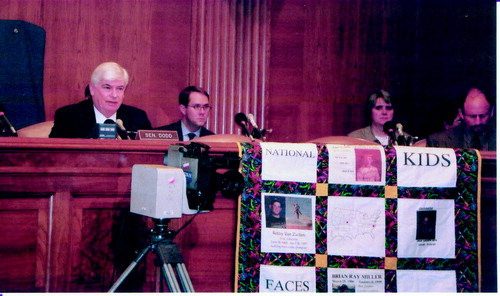More Efforts Needed to Curb Suicide Rate Among Teenagers
 Saddened by the suicides of two teenagers last year in his hometown of East Haddam, Conn., Sen. Christopher Dodd (D) channeled his concern into a fact-gathering mission by holding a hearing on teen suicide in their memory in September.
Saddened by the suicides of two teenagers last year in his hometown of East Haddam, Conn., Sen. Christopher Dodd (D) channeled his concern into a fact-gathering mission by holding a hearing on teen suicide in their memory in September.
Dodd, who chairs the Senate Subcommittee on Children and Families, said the number of teenagers who commit suicide is staggering. For young people aged 15 to 24, suicide is the third-leading cause of death, following unintentional injury and homicide.
“Unbelievably, more than 1.2 million American teenagers attempt to end their lives each year. This is unacceptable,” said Dodd.
That teen suicide was the topic of a congressional hearing is also due to the efforts of Surgeon General David Satcher, M.D., to raise the visibility of suicide as a public health problem that disproportionately affects the young and the elderly. Satcher issued a report on suicide, “A Call to Action to Prevent Suicide,” in 1999 (Psychiatric News, September 3, 1999) and the National Strategy for Suicide Prevention earlier this year (Psychiatric News, June 11).
Satcher emphasized that 90 percent of all suicides are related to mental health and substance abuse problems. “We know that effective treatments exist for these disorders and conditions, but the stigma surrounding these disorders prevents many persons, including teens, from seeking assistance.”
In addition, the stigma surrounding suicide makes it harder for teenagers to talk about their problems especially with adults, who might help them obtain treatment, said Satcher.
He noted that 1 in 10 children and adolescents has a mental health problem, but only 1 in 20 receives help.
Having access to mental health treatment is critical for teenagers contemplating suicide, but the lack of parity in health insurance often creates barriers to access, which is tragic, said Sen. Paul Wellstone (D-Minn) at the hearing. He is the coauthor of S 543, the Mental Health Equitable Treatment Act, which was passed by the Senate Health, Education, Pensions, and Labor Committee in September, but at press time its companion measure in the House still languished in committee. The delay reduces the likelihood that Congress will pass parity legislation this year.
Wellstone helped ensure the inclusion of suicide prevention programs in the Children’s Health Act of 2000 by appropriating $75 million for them and continues to advocate for appropriation of these funds this year, according to a press release.
Satcher testified that progress is being made to educate the public about suicide and mental illness. He mentioned several prevention efforts by federal, state, and private organizations:
• About 28 states have implemented some form of suicide prevention strategies in the last five years.
• The Centers for Disease Control and Prevention (CDC) has developed a Web site on the National Strategy for Suicide Prevention, which provides information on federal, state, and local efforts; funding resources; and youth suicide.
• The CDC is evaluating the effectiveness of suicide prevention hot lines.
• The National Mental Health Awareness Campaign launched its Signs for Life Teen Suicide Prevention Program in September to help teenagers, parents, and teachers identify the warning signs of depression and reduce the chances of its leading to suicide.
Satcher also made several recommendations to the subcommittee on how to strengthen efforts to prevent suicide among teenagers. States need federal technical assistance and funding to develop suicide-prevention programs that are coordinated with multiple agencies including education, mental health and public health, and justice.
“We also need to provide support to communities so they can identify and implement programs that are proven to work,” said Satcher. “Schools have designed programs that are not evidence based or have implemented proven programs in ways that they were not designed.”
John Mann, M.D., a professor of psychiatry at Columbia University College of Physicians and Surgeons and an expert on teen suicide, told Psychiatric News that the United States is lagging behind countries like Australia and New Zealand that have implemented national suicide education and prevention campaigns.
“We have not made a serious investment in suicide research and prevention. We need a network of treatment research centers to evaluate which treatments are effective,” said Mann.
The CDC National Strategy for Suicide Prevention Web site can be accessed at www.mentalhealth.org/suicideprevention. ▪



